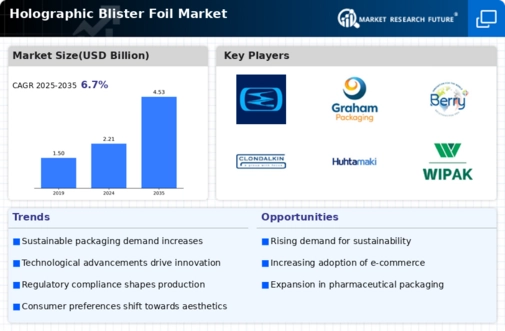Market Growth Projections
The Global Holographic Blister Foil Market Industry is projected to experience substantial growth over the coming years. With a market value anticipated to reach 2.21 USD Billion in 2024 and further expand to 4.53 USD Billion by 2035, the industry is poised for a promising trajectory. The forecasted compound annual growth rate (CAGR) of 6.75% from 2025 to 2035 suggests a robust demand for holographic blister foils across various sectors. This growth is indicative of the increasing adoption of innovative packaging solutions that cater to consumer preferences and regulatory requirements. As industries continue to evolve, the holographic blister foil market is likely to remain a focal point of development.
Expansion of E-commerce and Retail Sectors
The rapid expansion of e-commerce and retail sectors is significantly impacting the Global Holographic Blister Foil Market Industry. As online shopping continues to gain traction, the demand for visually appealing and secure packaging solutions has increased. Holographic blister foils are particularly well-suited for e-commerce applications, as they provide protection during transit while also enhancing product presentation. This trend is likely to bolster market growth, as brands increasingly invest in packaging that captures consumer attention in a digital marketplace. The integration of holographic foils in e-commerce packaging strategies is expected to drive demand, reflecting the evolving landscape of retail and consumer behavior.
Consumer Preference for Aesthetic Packaging
Consumer preferences are shifting towards aesthetically pleasing packaging, which is significantly influencing the Global Holographic Blister Foil Market Industry. Holographic foils provide a unique visual appeal that enhances product presentation, making them particularly attractive in the cosmetics and food sectors. As brands seek to differentiate themselves in a competitive marketplace, the use of holographic packaging is becoming more prevalent. This trend is expected to drive market growth, as companies recognize the importance of packaging in influencing consumer purchasing decisions. The aesthetic qualities of holographic foils not only enhance product visibility but also contribute to brand loyalty, further solidifying their position in the market.
Growing Pharmaceutical and Healthcare Sector
The pharmaceutical and healthcare sectors are significant drivers of the Global Holographic Blister Foil Market Industry, as these industries increasingly utilize holographic foils for packaging medications and medical devices. The need for tamper-evident and child-resistant packaging solutions has led to a surge in demand for holographic blister foils, which offer enhanced security features. With the global healthcare market expanding, the demand for innovative packaging solutions is expected to rise. This trend is likely to contribute to the market's growth, with estimates suggesting a market value of 4.53 USD Billion by 2035, reflecting the increasing importance of packaging in ensuring product safety and compliance.
Technological Advancements in Foil Production
Technological innovations in the production of holographic blister foils are playing a crucial role in the expansion of the Global Holographic Blister Foil Market Industry. Enhanced manufacturing processes, such as improved coating techniques and advanced printing technologies, enable the production of high-quality foils with superior visual appeal and functionality. These advancements not only increase efficiency but also reduce production costs, making holographic foils more accessible to a wider range of industries. As a result, the market is poised for growth, with a projected compound annual growth rate (CAGR) of 6.75% from 2025 to 2035, indicating a robust future for this segment.
Rising Demand for Sustainable Packaging Solutions
The Global Holographic Blister Foil Market Industry is experiencing a notable shift towards sustainable packaging solutions, driven by increasing consumer awareness regarding environmental issues. As companies strive to reduce their carbon footprints, the demand for eco-friendly materials has surged. Holographic blister foils, which can be produced using recyclable materials, are becoming a preferred choice among manufacturers. This trend is expected to contribute significantly to the market's growth, with projections indicating a market value of 2.21 USD Billion in 2024. The emphasis on sustainability not only aligns with regulatory requirements but also enhances brand image, thereby attracting environmentally conscious consumers.










